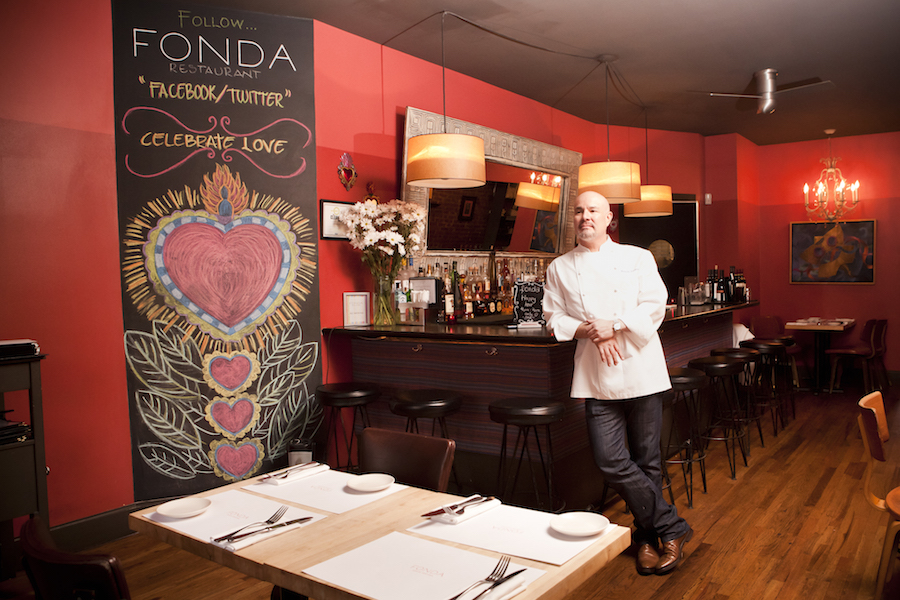It’s not that Roberto Santibañez aspires to be a 21st-century Julia Child—Julie Powell of Julie & Julia fame more or less has that ground covered. But with his just-released cookbook, Truly Mexican (John Wiley & Sons), the highly acclaimed chef/owner of Park Slope’s popular restaurant Fonda hopes to channel what Child did for French cuisine and eliminate the intimidation factor that often stands between American home cooks and great Mexican fare.
Child led that charge by hoisting beehived and be-Jelloed homemakers over cultural hurdles with her own culinary bible, Mastering the Art of French Cooking. Correspondingly, Santibañez, who hails from Mexico City, aims for his vivid tome to educate enthusiasts on how to cook authentic carnitas, enchiladas, tostadas and taquitos—all illuminated by his lessons on authentic, transcendent sauces. Instead of veering into well-trod topics like Mexico’s diverse regional cuisines and rich history, covered by the influential likes of Diana Kennedy and Rick Bayless, he focuses on the salsas, guacamoles, adobes, moles and pipiánes that form the backbone of Mexican flavors, offering step-by-step directives that are certain to vanquish that no-can-do mindset and replace it with a hearty sí se puede!
In much the same spirit as that famous big-boned dame, Santibañez aims to infuse a soupçon of much-needed levity into the making of a truly Mexican meal. Fittingly, he credits his fascination with Child in equal measure to her endearing flaws and accomplishments. He admires the way she taught America techniques for dishes they loved to eat, but didn’t know how to cook.“She did so beautifully, saying ‘don’t be scared—grab the chicken and cook it this way.’ And she sometimes got it wrong and she would laugh about it—it was fantastic.”
Coincidentally, Santibañez also trained at the Le Cordon Bleu in Paris, the storied culinary school where the indomitable icon herself first embraced the joys of cooking à la française, whisking her way into epicurean history. He found many French cooking methods to be a revelation, worlds away from those he grew up watching over his grandmother’s shoulder as she stirred her cazuela. He was amazed to learn that the addition or subtraction of a few ingredients could convert one so-called Mother sauce, say, béarnaise, into a Maltese.
In Truly Mexican, Santibañez hands readers the Mother-sauce keys to the cuisine of his homeland. Instead of scattering recipes for, say, moles, throughout the book, he presents them together—and reveals—eureka!—how alike they can be. “I’m just trying to [show] people, oh my God, the basic techniques give you all these possibilities,” he explains. “We Mexicans have made it seem, because of our historical facts and geographical diversity, much more complicated than it really is. Once you understand it, it’s so much simpler.”
Brooklynite bookmaster J. J. Goode, who’s currently collaborating on cookbooks with such culinary nobility as April Bloomfield, Zak Pelaccio and Aarón Sanchez, himself took on the project as a Mexican cooking neophyte, but came away with a new skill set, inhibitions long forgotten. “Mexican food is so popular, but people still do not cook it at home at all. And it’s really, really doable,” he insists. “I’d say it’s even easier than French food, even peasant French food—easier than beef Bourguignon, for sure.”
Goode joined Santibañez and Shelley Wiseman, the chef ’s longtime friend and the book’s recipe developer, countless times in one or the other’s home kitchen, and that’s where the knowledge in Santibañez’s head and hands literally got translated onto the page. “You get the best information when you’re cooking with someone,” says Goode. “Roberto’s very laid-back in the kitchen, and Shelley has her stopwatch and she’s saying, ‘Roberto, when did you add the water?’ He’s like, ‘I don’t know, Shelley, I just added it.’ It was like Abbott and Costello,” he laughs. “But it’s great to have that precision. You know chefs—‘it’s done when it’s done.’ And home cooks are like, ‘OK, what the hell does that mean?’”
Such exactitude has its rewards, as evidenced in recipes like “Pork in Adobo D.F.” (an abbreviation for Distrito Federal, or Mexico City). The five-ingredient adobo—a boldly flavored, blender-whirred puree of dried chiles, garlic, spices and vinegar—is laced with cinnamon, preferably canela (Mexican cinnamon), and as the pork shoulder chunks simmer, the sauce becomes spectacularly silky.
“I always speak about the platform of flavors, colors, textures that make cuisines what they are,” explains Santibañez. “We use many similar ingredients to China and India, but our food tastes distinct.” Mexicans, he points out, roast tomatoes, garlic and tomatillos, without one drop of oil, in the toaster oven or pan, until charred. And they toast chiles on a griddle, comal or heavy skillet, until blistered—core precepts passed down through the generations. “All these little factors give us these flavors that are particularly Mexican.”
Goode found such fundamentals an eye-opener—and exceptionally easy to master in his own kitchen. “I make stuff all the time now and it’s amazing how good it can turn out!” he raves, sounding a little surprised himself.
Somewhere up in food heaven, Julia Child must be smiling.
Santibañez is inspired by the way that famous big-boned dame taught Americans techniques for a cuisine they loved to eat—but didn’t know how to cook at home.
Photo credit: Carolyn Fong.



